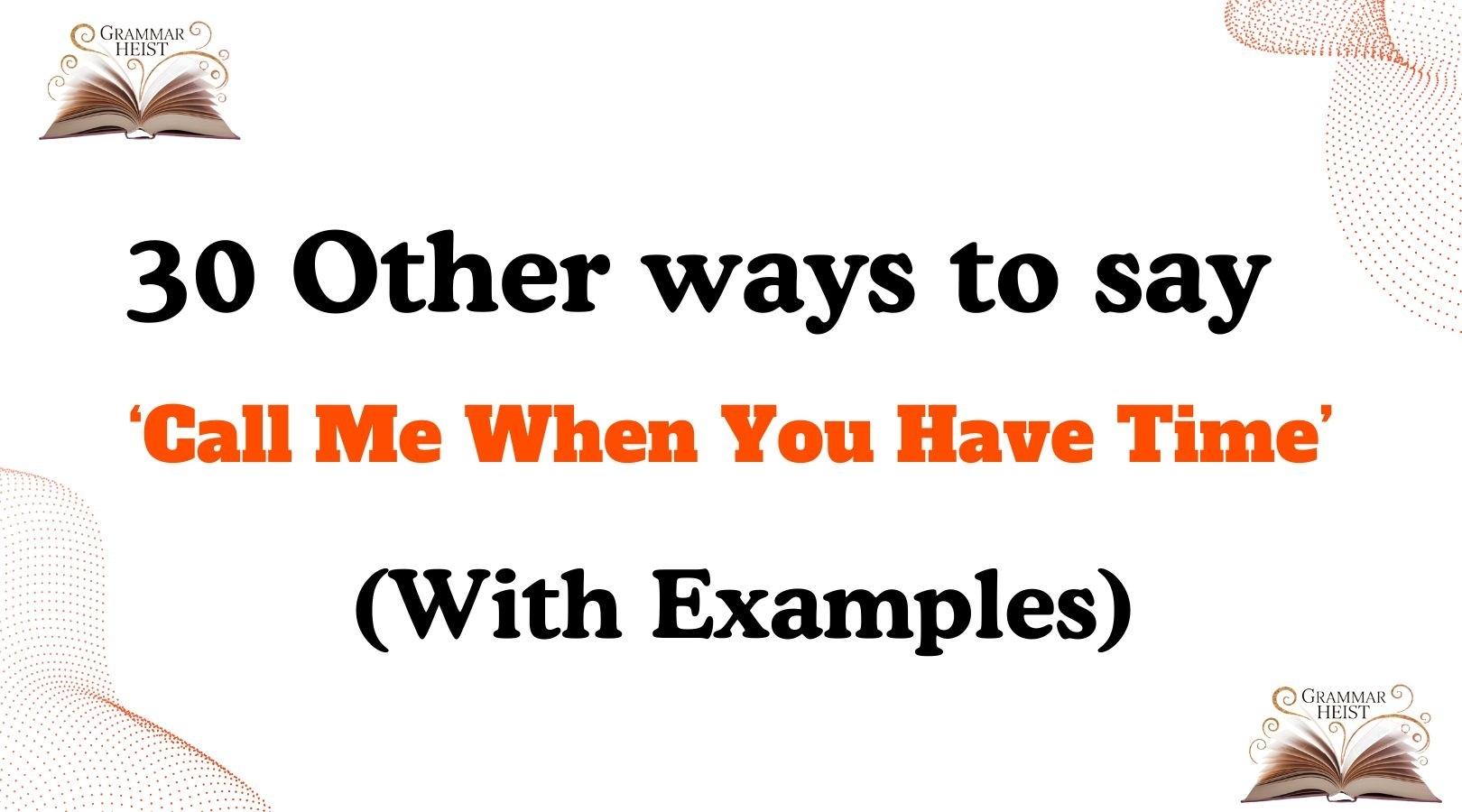Sometimes, the words we choose can change the way our message feels. A simple phrase like “call me when you have time” is polite, but it can sound a little routine or transactional. If you want to add warmth, show genuine care, or keep the tone professional yet thoughtful, choosing the right alternative can make your communication more personal and meaningful.
Below, you’ll find 30 alternative ways to say “call me when you have time”, with examples, tone guidance, and scenarios where each might fit best.
What Does “Call Me When You Have Time” Mean?
The phrase simply means you’d like someone to reach out by phone when it’s convenient for them. It’s a way of asking for a call without pressuring the other person, showing that you respect their time and schedule.
Is It Professional/Polite to Say “Call Me When You Have Time”?
Yes, it is both polite and professional. However, in some contexts it can feel a little plain or distant. Using warmer or more tailored alternatives helps you sound more caring, approachable, or even more professional depending on the relationship.
Pros or Cons
Pros:
- Shows respect for the other person’s time.
- Non-demanding and polite.
- Works in personal and professional settings.
Cons:
- Can sound generic or impersonal.
- May lack warmth or emotional connection.
- Doesn’t always convey urgency if needed.
Synonyms For “Call Me When You Have Time”
- Give me a call when it’s convenient for you
- Reach out to me when you get a chance
- Let’s talk whenever you’re free
- Call me when it’s a good time for you
- Whenever you’re ready, give me a call
- Ring me when you’re available
- Call me back when you can
- Let’s connect when you have a moment
- Call me when you get a breather
- Let me know when you’re free to talk
- Call me when it suits you
- Touch base with me when you have time
- Reach me when it works for you
- Get in touch when you can
- Give me a shout when you’re free
- Call me when it’s not a hassle
- Drop me a call when you’re able
- Contact me when you’re ready
- Let’s chat when you’re free
- Call me when things settle down
- Ring me when you get a chance
- Call me when you’re done with work
- Let’s talk when it’s a good time for you
- I’d love to talk when you’re free
- Call me when you feel up to it
- Whenever it works for you, call me
- Call me when you’re not busy
- Let’s catch up when you have a chance
- Hit me up when you’re available
- Talk to me when the time’s right
1. Give me a call when it’s convenient for you
Scenario: Perfect for professional emails or polite personal requests.
Examples:
- “Please give me a call when it’s convenient for you—I’d like to go over the project details.”
- “I’d love to catch up, give me a call when it’s convenient for you.”
- “Whenever you’re free, just give me a call—it doesn’t have to be right away.”
Tone: Polite, respectful, considerate.
Explanation: This wording adds professional courtesy and avoids sounding rushed.
2. Reach out to me when you get a chance
Scenario: Works well for friendly or casual communication.
Examples:
- “No rush, just reach out to me when you get a chance.”
- “If you’ve got a free moment, reach out to me when you get a chance.”
- “I’d love to hear your thoughts—reach out when you can.”
Tone: Warm, casual, approachable.
Explanation: This feels less formal and great for friends, family, or colleagues you’re comfortable with.
3. Let’s talk whenever you’re free
Scenario: Great for both professional and personal use.
Examples:
- “Let’s talk whenever you’re free, I don’t want to disturb your schedule.”
- “I’d love to catch up—let’s talk whenever you’re free.”
- “Let’s connect whenever you find some time.”
Tone: Friendly, collaborative.
Explanation: This shifts focus to shared conversation instead of just your request.
4. Call me when it’s a good time for you
Scenario: Works best when you want to sound thoughtful.
Examples:
- “Call me when it’s a good time for you, no pressure.”
- “Please call me when it works best for you.”
- “I’ll be around, so call me when the timing is right.”
Tone: Empathetic, patient.
Explanation: Highlights that you’re respecting their timing above all.
5. Whenever you’re ready, give me a call
Scenario: Ideal when discussing sensitive matters.
Examples:
- “Whenever you’re ready, give me a call—we’ll sort it out.”
- “I know you’re busy, but whenever you’re ready, call me.”
- “Take your time, and whenever you’re ready, reach out.”
Tone: Gentle, supportive.
Explanation: Shows understanding and lowers pressure.
6. Ring me when you’re available
Scenario: Friendly or casual, often used in UK English.
Examples:
- “Ring me when you’re available, I’ve got something exciting to share.”
- “Just ring me when you’re free to chat.”
- “No rush, ring me whenever you can.”
Tone: Casual, conversational.
Explanation: Adds a slightly informal and warm tone.
7. Call me back when you can
Scenario: Common when following up on missed calls.
Examples:
- “Hey, I missed you earlier—call me back when you can.”
- “I’ll be around, call me back when you’re free.”
- “Just wanted to check in, call me back when it works for you.”
Tone: Relaxed, understanding.
Explanation: Useful in everyday communication where flexibility matters.
8. Let’s connect when you have a moment
Scenario: Perfect for business or networking.
Examples:
- “Let’s connect when you have a moment to talk.”
- “I’d like to discuss this further—let’s connect when you have some time.”
- “Whenever you’re available, let’s connect.”
Tone: Professional, warm.
Explanation: Balances professionalism and friendliness.
9. Call me when you get a breather
Scenario: For friends or colleagues who are busy.
Examples:
- “Call me when you get a breather, I don’t want to interrupt.”
- “You’ve been swamped—call me when you catch your breath.”
- “Just reach out when you get a breather.”
Tone: Caring, empathetic.
Explanation: Shows you acknowledge their busyness.
10. Let me know when you’re free to talk
Scenario: Neutral and widely adaptable.
Examples:
- “Let me know when you’re free to talk about this further.”
- “Whenever you’re available, let me know.”
- “Just drop me a quick message when you’re free to talk.”
Tone: Friendly, flexible.
Explanation: Keeps it open-ended while showing interest in their availability.
11. Call me when it suits you
Scenario: Great for professional or polite personal communication.
Examples:
- “Please call me when it suits you, I’ll be available all day.”
- “Call me when it suits you, no rush.”
- “I’m flexible—just call me when it suits your schedule.”
Tone: Respectful, flexible.
Explanation: Shows you’re happy to work around their timing.
12. Touch base with me when you have time
Scenario: Useful in business or networking conversations.
Examples:
- “Let’s touch base when you have time, I’d like to go over the updates.”
- “Please touch base with me when it’s convenient.”
- “Touch base with me when you get a chance, we’ll finalize the details.”
Tone: Professional, collaborative.
Explanation: Adds a team-oriented feel while keeping it polite.
13. Reach me when it works for you
Scenario: Ideal for flexible or laid-back contexts.
Examples:
- “Reach me when it works for you, I’ll be around.”
- “Don’t stress, reach me when you’ve got the time.”
- “Just reach me when it fits your schedule.”
Tone: Relaxed, supportive.
Explanation: Makes the message sound unpressured and considerate.
14. Get in touch when you can
Scenario: Commonly used in both personal and professional settings.
Examples:
- “Get in touch when you can, I’d love to talk.”
- “Please get in touch when you have a free moment.”
- “Whenever it works, get in touch.”
Tone: Neutral, approachable.
Explanation: A simple alternative that keeps things open and light.
15. Give me a shout when you’re free
Scenario: Casual and friendly, great for close contacts.
Examples:
- “Give me a shout when you’re free, I’ve got news!”
- “Hey, give me a shout whenever you want to chat.”
- “No rush—just give me a shout when you’re available.”
Tone: Informal, friendly.
Explanation: Adds a fun, conversational vibe.
16. Call me when it’s not a hassle
Scenario: Best used when you want to acknowledge someone’s busy life.
Examples:
- “Call me when it’s not a hassle, I know you’re swamped.”
- “Whenever it’s easy for you, give me a call.”
- “No pressure, just call me when it’s not a hassle.”
Tone: Empathetic, caring.
Explanation: Shows you respect their comfort and don’t want to burden them.
17. Drop me a call when you’re able
Scenario: Simple, slightly more formal than casual phrases.
Examples:
- “Drop me a call when you’re able, I’ll be available all evening.”
- “Please drop me a call when you find some time.”
- “I’d appreciate it if you drop me a call when you can.”
Tone: Polite, neutral.
Explanation: A softer alternative that sounds friendly but respectful.
18. Contact me when you’re ready
Scenario: Especially helpful for sensitive or personal topics.
Examples:
- “Contact me when you’re ready, no rush.”
- “Whenever you feel comfortable, contact me.”
- “Just contact me when you’re ready to talk.”
Tone: Gentle, supportive.
Explanation: Perfect when you want to give someone space.
19. Let’s chat when you’re free
Scenario: Casual, perfect for friends or informal colleagues.
Examples:
- “Let’s chat when you’re free, I miss our talks.”
- “I’d love to catch up—let’s chat when you’ve got time.”
- “Let’s chat when you’re not too busy.”
Tone: Warm, friendly.
Explanation: Keeps the tone casual and welcoming.
20. Call me when things settle down
Scenario: Best for someone going through a busy or stressful time.
Examples:
- “Call me when things settle down, no rush.”
- “I know it’s hectic—call me when it eases up.”
- “Don’t worry now, just call me when life slows down.”
Tone: Caring, empathetic.
Explanation: Acknowledges their current stress while still inviting connection.
21. Ring me when you get a chance
Scenario: Casual and approachable.
Examples:
- “Ring me when you get a chance, I’d like to chat.”
- “Just ring me when it works for you.”
- “Please ring me when you have a minute.”
Tone: Friendly, easygoing.
Explanation: Lighthearted and commonly used in informal English.
22. Call me when you’re done with work
Scenario: Great for friends, family, or after-hours plans.
Examples:
- “Call me when you’re done with work, we’ll decide dinner.”
- “I’ll be waiting, call me when you finish up.”
- “Call me when you’re done at the office.”
Tone: Caring, personal.
Explanation: Shows you’re aware of their commitments and willing to wait.
23. Let’s talk when it’s a good time for you
Scenario: Professional but warm.
Examples:
- “Let’s talk when it’s a good time for you—I’ll be available all week.”
- “Please let me know when it’s a good time to chat.”
- “Let’s talk when the timing works best for you.”
Tone: Respectful, thoughtful.
Explanation: Shows you value their timing as much as the conversation.
24. I’d love to talk when you’re free
Scenario: Best for personal, warm communication.
Examples:
- “I’d love to talk when you’re free, it’s been a while.”
- “No rush, I’d love to talk whenever you’ve got time.”
- “I’d love to talk when you’re free, just let me know.”
Tone: Warm, heartfelt.
Explanation: Adds emotional depth compared to neutral alternatives.
25. Call me when you feel up to it
Scenario: Thoughtful, especially for someone who may be tired or unwell.
Examples:
- “Call me when you feel up to it, no rush at all.”
- “Whenever you feel up to it, just give me a ring.”
- “Call me when you’re in the mood to chat.”
Tone: Gentle, empathetic.
Explanation: Shows patience and care for their wellbeing.
26. Whenever it works for you, call me
Scenario: Broadly applicable for both casual and professional use.
Examples:
- “Whenever it works for you, call me.”
- “I’ll adjust—whenever it works for you.”
- “Please call me whenever it’s convenient.”
Tone: Flexible, respectful.
Explanation: Signals adaptability and openness.
27. Call me when you’re not busy
Scenario: Friendly, often used with close contacts.
Examples:
- “Call me when you’re not busy, I miss you.”
- “Just give me a call when you’re free from work.”
- “Call me when things slow down.”
Tone: Warm, easygoing.
Explanation: Shows you’re mindful of their busyness.
28. Let’s catch up when you have a chance
Scenario: Best for friends and acquaintances.
Examples:
- “Let’s catch up when you have a chance, I’d love to hear your updates.”
- “We should catch up soon—let’s do it when you’re free.”
- “Let’s catch up when you have some downtime.”
Tone: Friendly, casual.
Explanation: Highlights the joy of connection, not just the request.
29. Hit me up when you’re available
Scenario: Very casual, commonly used among close friends.
Examples:
- “Hit me up when you’re available, let’s hang out.”
- “Just hit me up whenever you’re free.”
- “Hit me up when you’re around, I’ll be home.”
Tone: Informal, playful.
Explanation: Best reserved for casual or personal chats.
30. Talk to me when the time’s right
Scenario: Thoughtful, works in sensitive or meaningful contexts.
Examples:
- “Talk to me when the time’s right, I’ll be here.”
- “Whenever it feels right for you, let’s talk.”
- “Talk to me when you’re ready, no pressure.”
Tone: Gentle, understanding.
Explanation: Conveys patience and emotional support.
Conclusion
At the end of the day, saying “call me when you have time” is polite and respectful—but sometimes, it can feel a little too plain. By choosing one of these 30 thoughtful alternatives, you can adjust your tone to match the relationship, whether you want to be professional, warm, supportive, or casual.

Emma Brooke is a passionate advocate for effective communication and language mastery. As a dedicated professional in the field of grammar and writing, Emma brings a wealth of knowledge and expertise to those seeking to improve their linguistic skills. With a focus on clarity, precision, and style, Emma Brooke is committed to helping individuals refine their language use to communicate confidently and effectively.












